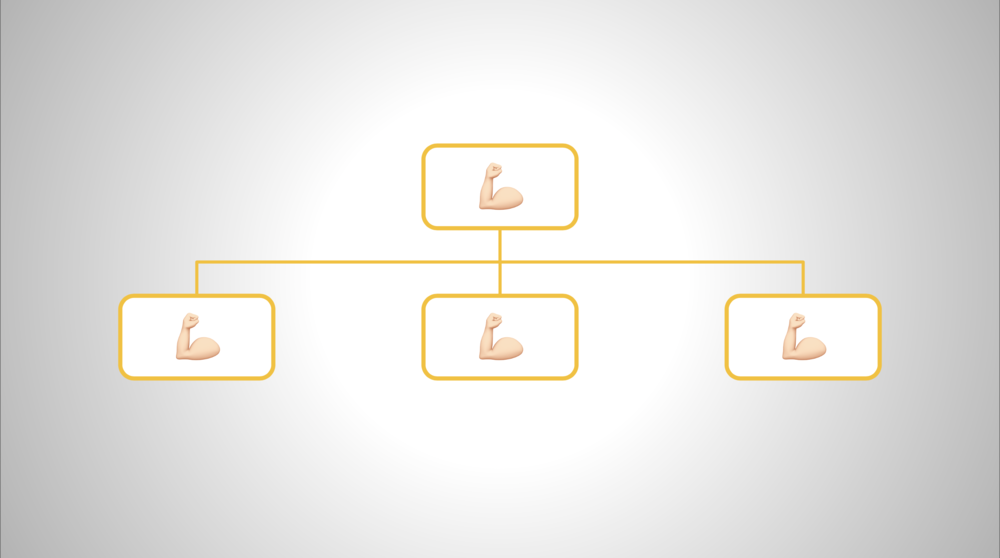
Read in this blog post how to choose the right organizational structure for your team.
Every company and entrepreneur wants their teams to perform at their full potential. A variety of factors influence your team; how they are structured is one of them.
This blog post explains in detail which options you have to structure your team, their general advantages and disadvantages, and for which situations which organizational structure is a good fit.
Next to the general factors that influence and define your structure, we’re going to look at:
- Functional Structures (Marketing Department, Finance Team etc.)
- Divisional Structure (based on product, region or customer segment)
- Matrix Structure (a combination of the above)
- Team-based Structure and
- Network Structure
Let’s get started 🚀
What is a high-performance team?
What high-performance means for a team is very individual for each team, but there are some common denominators when defining high team-performance.
- Task Performance: The ability to complete a given task within scope, budget, and time.
- Innovation: The ability to critically assess the status quo and improve and innovate.
- Cross-functional collaboration: The ability to work together on common goals instead of siloed interests.
- Managing complexity: The ability to simplify processes and tools in a way that allows for effective work.
- Speed and adaptability: The ability to adapt to changing environments quickly and effectively.
But isn’t organizational design the job of HR, you may ask? Well, maybe.
But the way you structure your team will have a direct effect on all of the above performance types.
Your organizational structure determines what your organization focuses on, where resources are being distributed to, and, first and foremost, how your team members will communicate.
So you better make sure it supports your strategic goals.
What are the elements of organizational structures?
Before we dive right into the different ways to structure your organization, let’s look at the dimensions that define an organizational structure.
COORDINATING MECHANISMS
Each team has to coordinate the work it does amongst its team members. There are three different types of coordinating mechanisms:
- Informal communication: This includes the chitchat on the hallway and temporary teams you might build for specific projects. This is all communication that happens outside of your formal hierarchy.
- Formal hierarchy: The classic model of a chain of command, where you define your organizational structure and reporting relationships. All communication flows through the lines in the org chart.
- Standardization: Routine work can be coordinated by standardizing it. The best example is standard operating procedures that in a way, replace a direct case-to-case management of work through a written description of how work is supposed to be performed.
The first two points can be defined by structuring your team. Check our blog post about standard operating procedures for the last point.
SPAN OF CONTROL
The span of describes how many people are managed directly by a given supervisor. Let’s say you’re the only person in your company that your team reports to and you have five employees, your span of control would be five.
When talking about the span of control, we usually think of tall structures and flat structures.
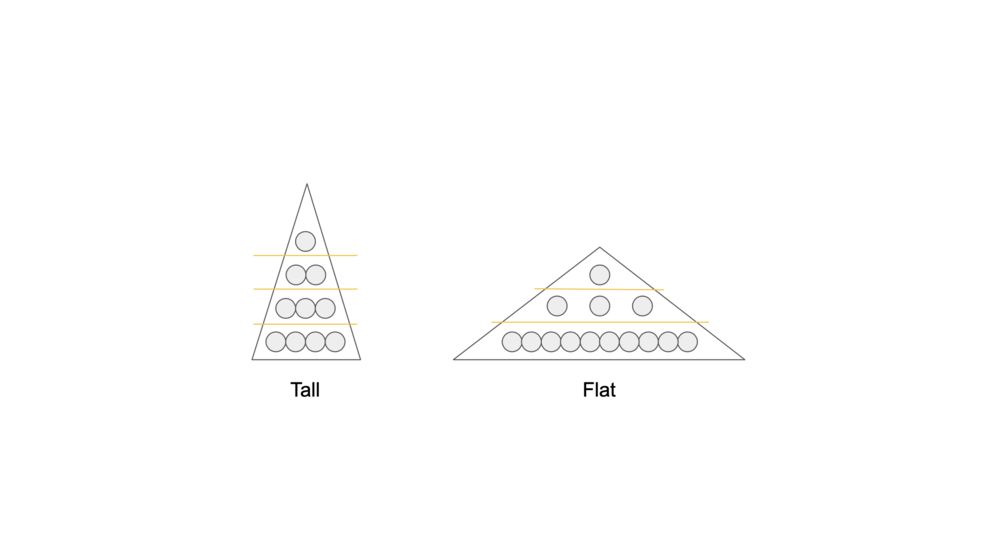
Tall structures have a narrow span of control (little number of direct reports) and many layers of management. They usually come with high overhead costs due to many managers and slow information flow.
Flat organizational structures have a wide span of control, but only a small number of hierarchy levels (e.g. only one level of middle management). If you’re the only manager in your company, you have a super flat structure.
The manageable span of control is larger if the tasks performed are routine, roles are not very highly interdependent and when the other coordinating mechanisms play a bigger role.
Let’s take an automotive assembly line, where tasks are highly standardized. The span of control might be ten or even 50 people.
On the opposite side of the scale, take an engineering team. Tasks are very unstandardized, and interdependency between a designer and the engineer is very high. Such a setup requires a much smaller span of control, say, five people.
CENTRALIZATION AND DECENTRALIZATION
In a centralized organization, power and decision-making are very much centralized in one position or person. Almost every startup starts in a very centralized setting, where the founder makes all the decisions and has all power.
As companies mature, decision-making power becomes more decentralized and is distributed across different departments or regions.
For different types of decisions, centralized and decentralized decisions can exist parallelly in the same company. Think about strategic decisions made centrally by the CEO, whereas pricing or marketing decisions are being made decentralized by and for each market or product line.
FORMALIZATION
Formalization describes how decision-making, work performance and other parameters in your organization are standardized by rules, SOPs and other tools.
Formalization is usually used in stable environments as it reduces flexibility.
MECHANISTIC VS. ORGANIC STRUCTURES
Combining those three elements of organizational structures, we arrive at the concept of mechanistic vs. organic structures.
Mechanistic structures are characterized by a narrow span of control, which results in a very hierarchic organization. Power is centralized at the top of the hierarchy pyramid, and formalization is high.
Thus autonomy amongst employees is low. Those organizations are well suited for very stable and unambiguous environments.
Organic structures are characterized by a wide span of control. As also formalization is low, team members have to work very autonomously. To accommodate that, power is decentralized.
Due to higher speed and adaptability, these organizations work best in dynamic, ambiguous environments.
The different types of organizational structures
Startups naturally develop a simple structure at the beginning. Everyone is reporting to the founder, so power is highly centralized. Job profiles are not yet highly divided or specialized because there isn’t enough personnel to do that. So the range of tasks for each individual is fairly broad.
After that straightforward phase, usually, with below ten employees, companies develop first organizational structures. The way in how you departmentalize your work defines your team structure.
As said above, the way you group people will define what your organization focuses on, how resources are distributed and how informal communication happens.
So let’s dive into the different types of organizational charts.
FUNCTIONAL STRUCTURES
The first structure you will naturally develop if you don’t deliberately design it differently is a functional structure, where you structure your talent by the functional areas that you have.
That means you will build a marketing team, a sales team, an engineering team, a human resource team and a finance team (or whatever other functions you have).
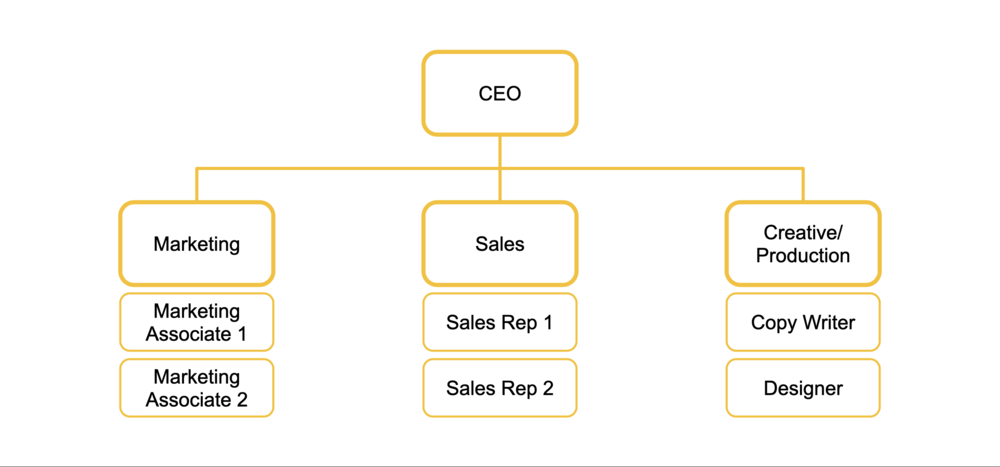
Probably one of the most common organizational charts, the advantages of functional structures are that you build and utilize expertise on the subject matter in the different teams. Teams can easily develop great team cohesion and identification with their role (“we are the marketing team”,” we are customer service”).
Furthermore, functional structures are fairly easy to manage as roles and responsibilities, and reporting structure, are fairly straightforward: Functional managers manage their teams and report to senior leaders or the leadership team.
On the downside, functional structures are prone to develop silo thinking and lose sight of company goals. The strong focus on function often comes with a weaker focus on customers or products.
DIVISIONAL STRUCTURES
As soon as companies diversify offerings or the geographic regions they serve, they often shift to a divisional structure. Building a divisional structure is great if you want to focus your organization’s attention on either different products or services, different markets or different customer groups.
In a divisional structure, you will group your teams around said topics, e.g. you have a division for small business, one for medium-sized businesses and one for corporate clients. In a product-based divisional structure you might have one department for each product line.

The divisional structure will steer attention to the very dimension you build your division around, so it’s a great tool if you want to establish a product or customer-focused organization.
It’s easy to add divisions, e.g. if you enter a new market, start working with new customer segments or add products.
Disadvantages include that you will often develop duplicate functions, e.g. two or three sales teams, and accordingly, expertise is spread out. This makes a divisional structure hard to realize for small teams, and in fact, it is more common on in large companies.
Additionally, it’s not easy to find the best solution to go for when deciding what build your divisions around. There are large corporations that restructure every few years, hopping from a product-focused to a customer-focused organization and back again a few years later, as there is no right way to do it.
Finally, a divisional structure also might foster silo-thinking, where one division pursues their own goals while sacrificing the success of other divisions.
MATRIX STRUCTURES
To eliminate the choice problem in the divisional structure, matrix structures combine different divisional approaches. Teams or individuals will be reporting to different division heads simultaneously, e.g. to a head for a regional division and at the same time to the head of a product line.
Another type of matrix structure combines functional with project-structures.

In both cases, matrix structures have the benefit that they allow for a focus on divisional or project goals and, at the same time, support functional expertise. In this way, a matrix structure makes fair use of resources and expertise and can foster innovation.
This is especially true for smaller teams, where there is no reporting to division or functional team leaders, but rather each functional expert also takes over the project lead and adds other functional experts/project managers to their own project as needed.
This approach of course requires a highly skilled team where each functional expert can take over the role of a project manager.
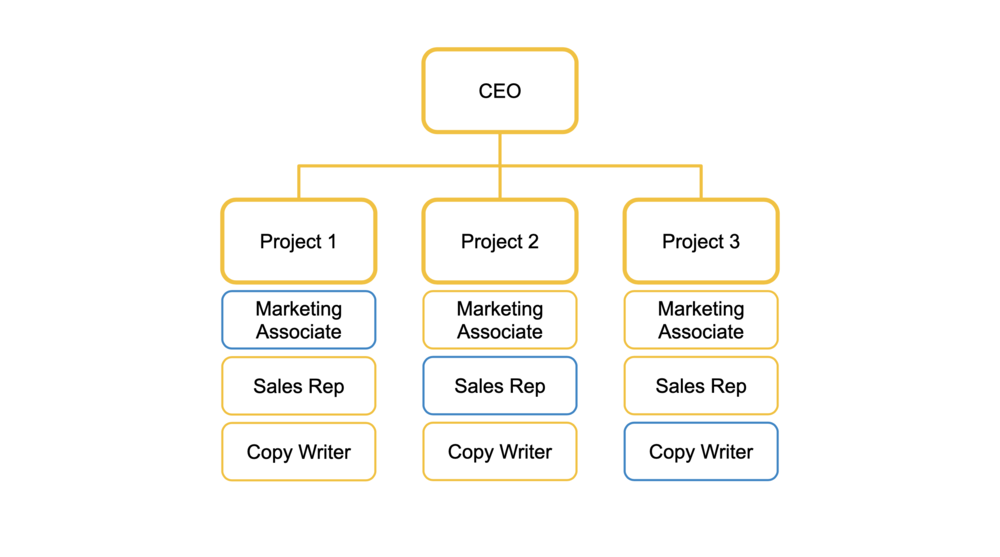
The combination of divisional focus and functional expertise makes matrix structures a right choice in very complex environments.
The biggest disadvantage is the ambiguous accountability for competing team leaders or priorities and many stakeholders on each role. To limit confusion and resolve this, most matrix organizations have solid lines to one boss and dotted lines only to the other boss. Again, this problem is not as severe for smaller teams.
TEAM-BASED STRUCTURES
This very organic structure features cross-functional teams that deliver one whole piece of service or product. Agile teams often operate in team-based structures.
These teams are self-directed to a large degree, operate with very little formalization and have decision-making power.
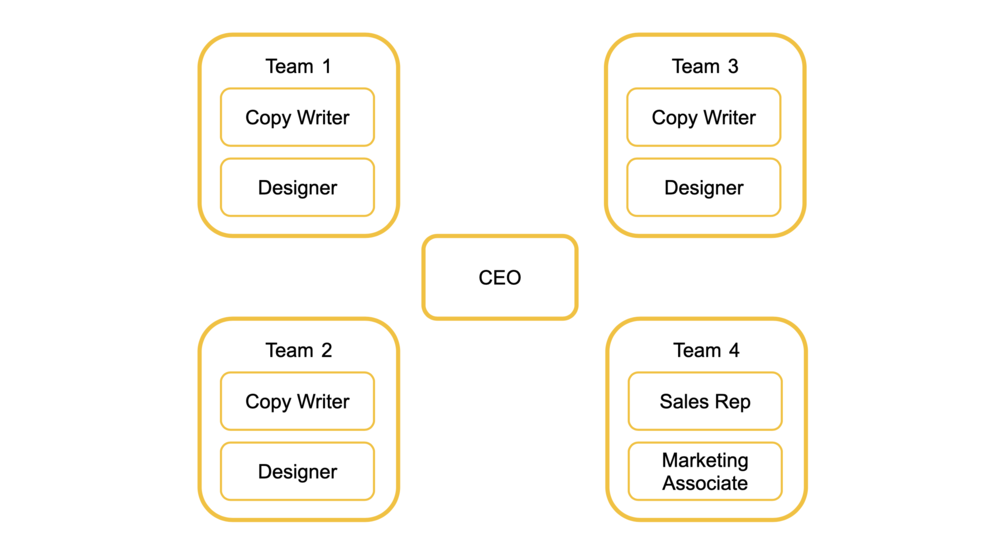
Team-based structures are highly adaptable, flexible and responsive to new outside challenges. Due to the decentralized power and good communication, decision-making tends to be quick and good.
Approval workflows through hierarchical structures are replaced by decision-making guidelines, feedback and peer reviews. There’s a free flow of information.
Once established, self-directed teams can reduce costs because the need for a hierarchical overhead is lower. If staffed with people that can navigate such an open environment, employee engagement tends to be very high and teamwork usually is effective.
On the down-side, self-directed teams require a lot of effort when implementing, from functional cross-training to interpersonal training. Not all professionals like and can cope with the role ambiguity that comes with such a structure.
Lastly, there is a risk that self-directed teams compete with each other. While this can be healthy, competition can also harm the interests of your organization as a whole.
NETWORK STRUCTURE
Network structures have become very popular in the last decades through platform business models and the rise of the gig economy. At the core of a network structure there is one customer-facing company that organizes third-party satellites (or sometimes own legal entities) to perform the work.
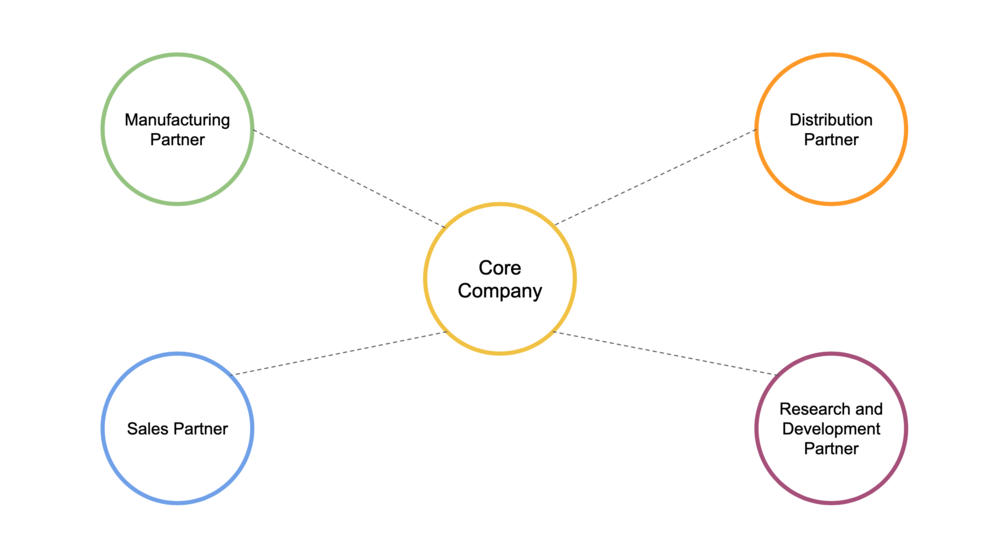
The biggest advantage of such a structure is its flexibility, where you can quickly add or eliminate services or products. For this reason there’s been a trend in the last year especially for fast growing online companies to work in networks. Also outsourcing parts of your operation to freelancers can be considered a network structure.
Network structures are hard to manage and expose the core company to market forces. A classical organization builds know-how and learns, a network organization does not benefit from that but has to rely on external partners continuously.
MIXED STRUCTURES
In reality, companies are often structured in a mix of the above. One part, e.g. the bookkeeping, might operate in a rather mechanistic functional structure, whereas another part, e.g. the development team, works in a team-based structure.

Choosing your structure
Now that we touched on the main types of structure, one question remains: Which organizational model is right for you? Let’s look at three different influences factors: Environment and strategy as well as size.
ENVIRONMENT AND STRATEGY
The following are some simplified recommendations. Please keep in mind your situation might have contingencies that change the recommendation.
- If your environment is fairly stable, simple and your strategy aims at economies of scale and low-cost, then go for a mechanistic structure. This could be a functional structure with many SOPs in place and where you, as the founder, still hold most of the power.
- If your environment is dynamic, complex and your strategy is rather innovation, then go for an organic structure. The most organic structure being the team-based structure. If implementing a team-based structure might sound too intimidating, think about using a matrix-structure with decentralized power.
- If your markets are integrated, a functional and centralized structure might work well to optimize for your one clients/product/region. If your markets are rather diverse, a divisional structure might cater to this environment well.
COMPANY SIZE
The bigger a company gets, it usually:
- becomes more standardized and formalized
- develops a more decentralized power structure
- becomes harder to transition from one org structure to the other or to redesign parts of it.
TOO SMALL FOR AN ORGANIZATIONAL STRUCTURE?
When you just started or your team is relatively small, you might don’t see another structure that works for you than the functional one, whee one person is the marketing department, another person is the sales department etc.
You might still make use of the focus that the matrix structure provides. It is the only one that doesn’t require you to add resources and still allows you to set your organizational focus on what you think is essential.
You can implement that by assigning responsibility for one market, client segment or product to each individual. Keep in mind that each individual has limited capacity, and they might need training on what you want them to do.
Furthermore, even if you are not big enough yet for the other structures, it is valuable to go through the thought process of choosing one. The result will be your target org structure, a goal to work towards.
It will direct your efforts regarding recruiting (who you need is determined by what structure you want to build) and standardization (do you really need SOPs if you are aiming at a team-based structure).
Enjoy building your structure and implementing it.
Happy Scaling!
Best
Benjamin